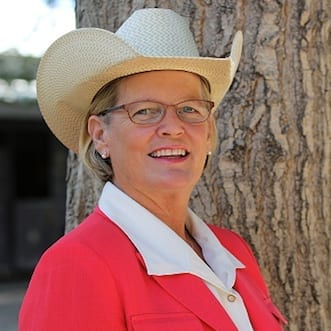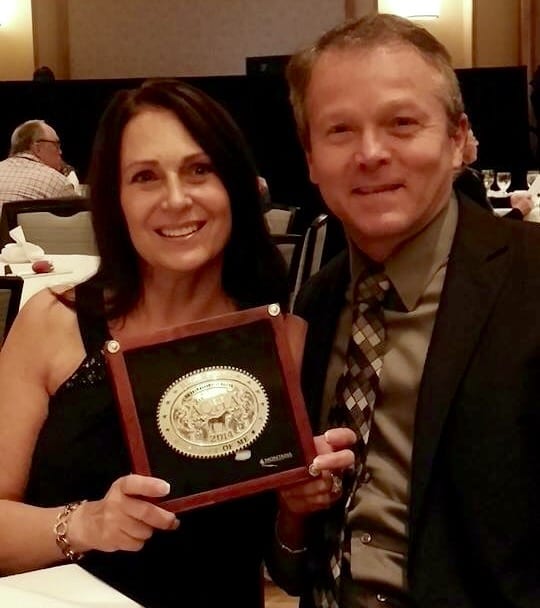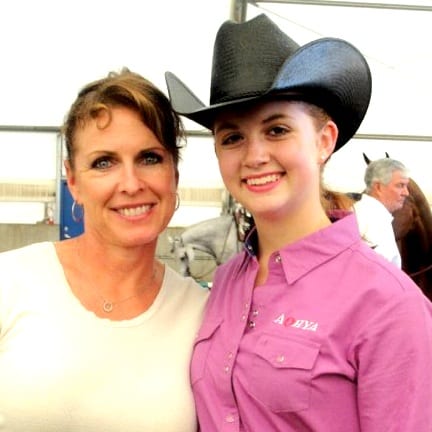What does it take to be on the top of the judge’s cards when you’re at larger shows such as the World Show or Congress? With the AQHYA World Championship show starting on Friday, we wanted to ask past World Show and Congress judges, Holly Hover, Robin Frid, Pierre Briere, Rhonda Replogle and Kendra Weis what exhibitors can do to positively stand out in steep competition and what “It” takes to walk out of the arena with a coveted gold, silver or bronze trophy in hand.
Holly Hover of Cave Creek, Arizona
Holly Hover of Cave Creek, Arizona judged the 2015 AQHYA World Show, along with many other World Shows and the All American Quarter Horse Congress. She has been a Professional Horsewoman since 1980 and started judging 26 years ago. In that time, Hover has produced 18 All American Quarter Horse Congress and AQHA World Champions and Reserve Champions in various pattern events.
 When asked about the importance of an exhibitor’s first impression, particularly at shows with larger numbers such as the Youth World, Hover said, “That first impression is powerful in that it really sets the pace for the judge’s expectation of what is about to unfold.”
When asked about the importance of an exhibitor’s first impression, particularly at shows with larger numbers such as the Youth World, Hover said, “That first impression is powerful in that it really sets the pace for the judge’s expectation of what is about to unfold.”
Hover continues, “Begin with a quiet, balanced, correct presentation with your horse in frame as you await the signal to begin. Establish strong confident eye contact with the judges. You must be in perfect position. You, your horse, everything must be turned out to perfection: tack, clothes, hat shape, grooming, clipping, clean, oiled and polished. Confidence is a powerful component to a first impression. Be prepared. Know your thought process and believe in yourself and your horse.”
We then asked what separates a “good” pattern from an “excellent” pattern, Hover replied, “A good pattern is correct with strong maneuvers and is executed by a thoughtful rider with a solid horse. It has flow and balance. The excellent pattern has all of these same components with an amped up level of ‘guts’ and ‘aggression’. It has crisp transitions, the speed, the footwork, the pattern placement, rider position, horse in frame and moving correctly with everything knocked out at the highest degree of difficulty. Not too much, not to the point of recklessness or the ‘overdone’ but the type of performance that makes a judge say ‘wow’.”
Hover’s definition of the ”It” factor an exhibitor needs in order to be first on her card is, “That total harmony between the horse and rider. The complete understanding and trust each have for the other. There is a unique communication that is evident in those very special teams. Hard to describe, but definitely easy to see.”
Robin Frid of Denton, Texas
Robin Frid of Denton, Texas judged the All American Quarter Horse Congress in 2014. He is a Professional Horseman and judge, whose clients have a combined 38 World and Congress Champions and Reserve Champions in horsemanship and showmanship.
 To Frid, “There is no doubt the importance of a first impression. This is a time when you as the exhibitor can either create an average thought in my mind or make me sit up and get ready to score. In all cases confidence sells. Be prepared when you the enter the arena and remember that you are a salesperson trying to get me to buy the product you are selling.”
To Frid, “There is no doubt the importance of a first impression. This is a time when you as the exhibitor can either create an average thought in my mind or make me sit up and get ready to score. In all cases confidence sells. Be prepared when you the enter the arena and remember that you are a salesperson trying to get me to buy the product you are selling.”
One of his largest “pet peeves” is an exhibitor that is in no way prepared when they enter the arena. He said, “If you needed more time to get ready you should have gotten up a little bit earlier that morning.”
We then asked what separates “good” from “excellent” pattern and Frid stated, “One of the main aspects that separate a good pattern from an excellent one is pattern placement. Where you lay out the picture in the arena can have a huge impact on me and will definitely affect the final score.”
Exhibitors often ask what they can do to positively stand out in a class with over 200 competitors. Frid said, “In large classes there are so many things that can make you stand out. For me, the largest of these is your ability to keep your horse in frame and in rhythm with you at all times. I want to look at the picture and know that the rider/handler are in full communication with one another.”
Frid’s definition of the “It” factor is all of those things combined. “An exhibitor that turned out well, meaning clothes that fit, are clean and have a clean and well-shaped hat. The horse is well groomed, healthy looking, and has clean tack on it ready to perform. I want to be excited to judge them as soon as I look at them, see good pattern placement with a high degree of difficulty, and have complete control of every step the horse takes. As stated earlier you are a salesperson. Confidence sells.”
Pierre Briere of Stockton, NJ
 Pierre Briere of Stockton, New Jersey also judged the 2015 AQHYA World Show and All American Quarter Horse Congress. In 2009, Pierre won the Junior Western Riding at the AQHA World Championship Show.
Pierre Briere of Stockton, New Jersey also judged the 2015 AQHYA World Show and All American Quarter Horse Congress. In 2009, Pierre won the Junior Western Riding at the AQHA World Championship Show.
According to Briere, to make a strong first impression in the arena, “Look ready, be ready, (have a) clean outfit, well-shaped hat, clean tack, a clean and well-groomed horse.”
One of his biggest pet peeves disconnection between horse and rider. “You and your horse are a team, you two work together to execute any patterns given to you so a well-connected team is one that looks like they have spent hours practicing and preparing. When you look like your horse knows what you are thinking and vice versa, you are connected.”
Briere differentiates a “good” from an “excellent” pattern “from a horse and rider team who are perfectly connected in their execution of all the maneuvers. A team that knows their strengths can capitalize on executing their strongest maneuvers at a high degree of difficulty while executing other maneuvers at a level where their horse can remain confident and correct.”
In his opinion, there isn’t one thing that makes you stand out better than a horse and rider team that has practiced, practiced and practiced. “A good pattern judge can tell by the second maneuver if you have spent hours practicing at home and at the show.”
Briere’s definition of someone displaying the “it” factor is, “An excellent rider coupled with a talented horse, but having said that the excellent rider and great horse team who aren’t quite prepared will not always dominate. Be prepared, connected and ready, there is no better formula for success than practice and hard work.”
Rhonda Replogle of Clear Spring, Maryland
 Rhonda Replogle a Professional Horsewoman of Clear Spring, Maryland has judged multiple AQHA World Shows and the All American Quarter Horse Congress. She has trained numerous World and Reserve World Champions.
Rhonda Replogle a Professional Horsewoman of Clear Spring, Maryland has judged multiple AQHA World Shows and the All American Quarter Horse Congress. She has trained numerous World and Reserve World Champions.
Replogle stressed that in order to make a strong impression in the show ring, you must “be well prepared for whatever event you are entering. First is to know the rules of that event with lots of hard practice. In a pattern class, a pet peeve of mine is one that doesn’t have a plan to execute the pattern correctly or utilizing the cones correctly.”
We then asked her what distinguishes a “good” from an “excellent” pattern on her card, “An excellent pattern is the exhibitor’s body in the correct position and executing the pattern accurately, smoothly, quickly with professionalism. A good pattern is one that lacks the precision and execution of the pattern and the finest of the excellent pattern.”
The way to catch Replogle’s eye within a huge class is “appearing confident and knowing how to get the maximum performance out of your horse. Appearing to be totally connected to your horse.”
To Rhonda, the “It” factor is “to be totally connected with your horse in everything you do. It’s not on who has the most sequins on their shirt or how much your outfit costs, it’s more on who practiced the most.”
Kendra Weis of Moberly, MO
 Kendra Weis is an AQHA World and Congress Champion trainer and judge from Moberly, Missouri. She has also judged the AQHA World Championship show. She believes there are several things that a competitor can do to leave a lasting impression on the judge. “It is paying attention to the small details,” Weis states.
Kendra Weis is an AQHA World and Congress Champion trainer and judge from Moberly, Missouri. She has also judged the AQHA World Championship show. She believes there are several things that a competitor can do to leave a lasting impression on the judge. “It is paying attention to the small details,” Weis states.
For starters, the showman should “wear an outfit that compliments them and their horse, a hat cleaned and shaped, hair fixed, boots polished, number pinned on straight and manicured nails.”
As for the horse, it should be “clean, clipped, shod properly, show equipment that fits and is clean.” Weis continues, “All of these things build the case to the judge that you are in the class to win.”
One of Weis’ biggest pet peeves pattern classes is when riders “do not ride to win. Judges sit and watch pattern after pattern are your biggest cheerleader, however, we would like for you to give us something to cheer about…as in an excellent score of 90 to 100.”
Weis also explained how separating good patterns from excellent patterns is “really quite easy for a judge. A good pattern is one that is performed in a correct manner. The good pattern executed with precision and correctness but lacks the ‘wow factor’ that the excellent pattern demonstrates. The excellent pattern is like a great song. The rhythm and flow between horse and rider is of utmost precision. One maneuver flows into the next with correctness of rider and horse. It takes countless hours of practice with horse and rider to excel in the excellent category.”
In order for an exhibitor to display the “It Factor,” Weis believes, “Each rider needs to perform to the best of their ability. Learn the areas you and your horse can excel. Remember you have to sell the package to the judge that you are in it to win it. Practice, practice, practice because when you get to the big shows the atmosphere is different and horses reactions could be different as riders nerves increase with pressure. Smile and enjoy the ride!”








